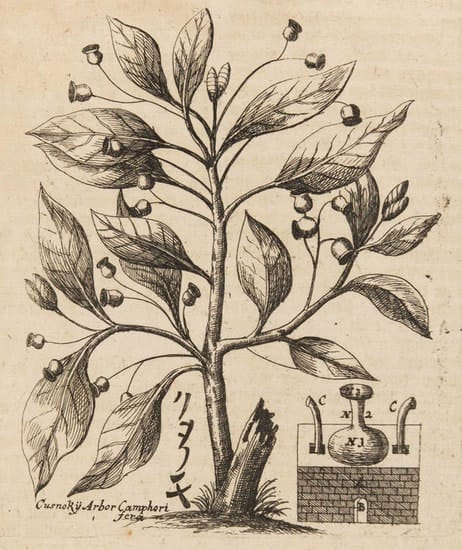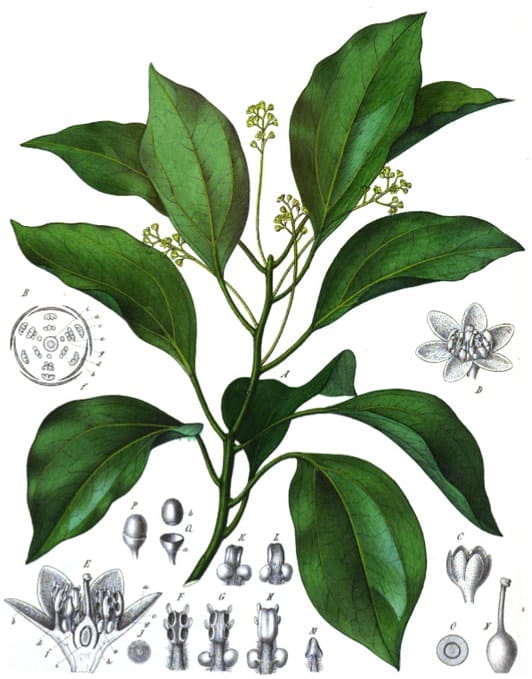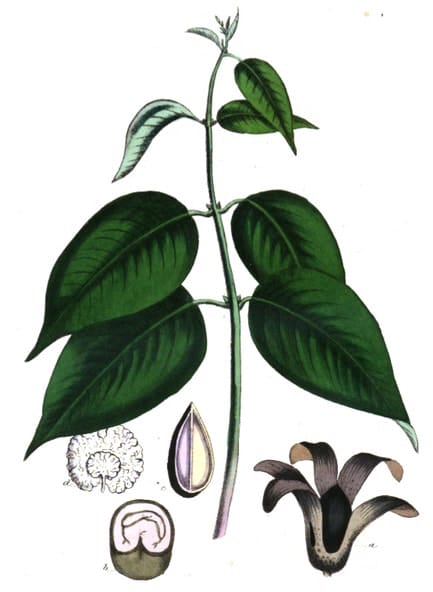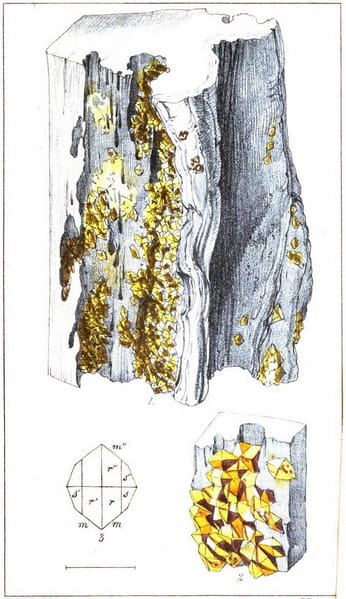Camphora, Camphor, Zhang Nao 樟脑Borneo Camphor, Bing Pian 冰片Camphor:–Zhang Nao 樟脑 (TCM) –Ga Bur ག་བུར (Tibetan) –Karpoor (Unani) –Karpura, Pakva Kapura (Ayurveda) Borneo Camphor, Nagi Camphor: –Bing Pian 冰片 (TCM) –Mang ga bur མང་ག་བུར (Tibetan) –Kakronda (Unani) –Kukundara, Apakva Kapura (Ayurveda) |

|

|
 Museum Museorum, Valentini, 1704
Museum Museorum, Valentini, 1704
 Cinnamonum camphora
Cinnamonum camphoraAtlas der officinellen pflanzen, Felix, 1899 |
 Dryobalanops aromatica (Borneol Camphor),
Dryobalanops aromatica (Borneol Camphor),Medical Botany, Bohn, 1832 |
 Crystals of Natural Borneo Camphor
Crystals of Natural Borneo CamphorHookers Journal of Botany, 1854
Botanical name:
Two different medicines can be considered under “Camphor”:
- Camphor: Cinnamonum camphora;
- Borneo Camphor: Dryobalanops aromatica; Blumea balsamifera
Parts used:
Gum; Purified Crystals
Temperature & Taste:
Hot, dry. Pungent, aromatic
In Ancient times in both East and West it was regarded as Cold, the ‘modern’ say Hot. (Salmon)
“Cold and dry in the third degree”. (Avicenna)
Classifications:
2G. CLEANSING. 2H. CARMINATIVE. 2I. ANTISPASMODIC. 2R. NARCOTICS & HYPNOTICS
3A. SUDORIFICS & DIAPHORETICS. 3B. FEBRIFUGE & ANTIPYRETIC. 3D. CORDIALS & CARDIACS. 3E. DIURETIC
4a. CEPHALIC. 4c. CARDIAC. 4g. HEPATIC. 4j. NERVINE. 4k. ARTHRITIC
TCM:
J. Aromatics that Open the Orifices (Borneo Camphor)
T. External Medicines (Camphor)
Uses:
1. Clears Heat, Resists Poison (West, Tibetan, Ayurveda, TCM):
-preventative to Epidemic diseases, Colds, Influenza
-much used for Fevers in classical times (still in Unani and Tibetan Medicine): High Fever, Burning Fever
-Cholera, Typhoid, Malaria, Meningitis, Septicemia etc.
-promotes expression of rashes in Small Pox and Measles
-Venomous bites
-Antidote to Aconite poisoning (Ayurveda)
-‘disperses invading pathogenic Heat resting in the Heart.’ (Wang Hao Gu)
-“helps febrile patients to regain consciousness” (Avicenna)
-“useful in severe Headache associated with acute Fevers” (Avicenna)
2. Moves Qi, Opens Obstructions, Eases Pain (West, Tibetan, Ayurveda, TCM):
-injuries, bruises, strains, sprains
-Rheumatic and Arthritic pain
-Headache
-Angina Pectoris, Chest Pain; useful Cardiac stimulant
-also to promote Childbirth (West, TCM)
3. Opens the Orifices of the Brain (West, Tibetan, Ayurveda, TCM):
-delirium, coma, unconsciousness, especially when associated with Febrile disease
-Hysteria, Nervousness, Faintness, Neurasthenia, Depression
-‘treats deafness, brightens the eyes’. (Tang Ben Cao)
-‘effective to treat apoplexy with profuse salivation’ (Kou Zong Shi)
4. Clears Phlegm and Damp (West, Tibetan, Ayurveda, TCM):
-Cold, Flu, Catarrh, Sinusitis
-Bronchitis, Asthma
-irritable Bladder with constant desire to urinate
5. Aphrodisiac:
-short-term use is aphrodisiac (West, Tibetan, Ayurveda, TCM)
-chronic use or large doses were said to ‘kill Lust’ (West, Tibetan, Ayurveda, TCM).
-‘consolidates Essence’ (Ben Cao Gang Mu)
6. Kills Worms: (West, Ayurveda, TCM)
-Worms, Parasites
7. Externally (West, Tibetan, Ayurveda, TCM):
-relieves Pain and inflammation; Bruising, Trauma, Muscle or joint pain
–Ulcers, Scabies, Gangrene, Dermatosis, Dermatitis
-One grain was put into a hollow and painful Tooth
-Nebula of the eye, red and inflamed eyes
-Polyp of the nose (Li Shi Zhen)
-‘treats Five kinds of Hemorrhoids’. (Ben Cao Gang Mu)
-“used in hot Ophthalmia” (Avicenna)
Dose:
Although used similarly, Camphor is now only used externally; Borneol Camphor is used internally.
Borneo Camphor: 50–250mg
Comment:
When camphor is powdered, the mortar and pestle should be anointed with Sweet Almond Oil to facilitate its pulverisation; or, it is beaten with a little piece of blanched almond.
Correctives:
1. Musk, Castoreum
2. Rose Conserve, Violet
3. Amber
4. Orris oil
Substitutes:
1. Tabasheer
2. White Sandalwood. (Unani)
3. Mint oil
Main Combinations:
Camphor & Saffron
1. Fever:
i. Fever, Spotted Fever, Epidemic disease, Apoplexy, Lethargy, Migraine, combine Camphor with Saffron (as in Elixir of Camphor)
ii. For Fever, Camphor is used with Tabasheer and Sandalwood. This is the ‘King and Minister’ combination of Tibetan Medicine, much used for Fever. Other additions to this trio include Saffron, Bezoar, Picrorhiza and Swertia. This combination is also used in Unani
iii. All types of Fever including Malaria and Meningitis: Camphor with Nutmeg, Clove, Tabasheer, Saffron, Cardamon, Sandalwood, Swertia (Tibetan)
iv. Burning and Spotted Fevers, heat of Blood or Bile; heat of the Stomach or Liver; Camphor with Saffron, Rose, Tragacanth, Cucumber seed, Licorice (as in Troches of Camphor)
v. High Fever, Camphor with Sandalwood, Tabasheer, Bezoar and Lotus seed (as in Pills of Camphor of Unani)
2. Infectious Diseases (Pestilence, Plague):
i. Camphor with zedoary, white dittany, gentian, Scordium, Blessed Thistle, Sorrel
ii. Camphor with Angelica, Bay berry, Round Birthwort, Gentian, Nutmeg
iii. Camphor with Diatessaron, Angelica,
3. Stomach weakness, wind, flatulence: Camphor with Saffron, Nutmeg, Black Pepper, Ginger, Cinnamon, Basil (as in Electuary of Camphor of Unani)
4. Diarrhea with Phthisis (consumption): Camphor with Sandalwood, Rose, Gum Arabic, Tabasheer, Poppy seed, Pumpkin seed (as in Astringent Tablets of Camphor of Unani)
5. Heart stimulant, Angina Pectoris: drops are prepared with Hawthorn and Camphor (Modern Europe)
6. Small Pox when Heat affects the Heart, Borneo Camphor with Pig Blood (Ben Cao Gang Mu)
7. To lessen sexual desire, use Camphor with Rue
8. To stir up Yang, Borneo Camphor, Musk, Cinnamon, Aconitum Fu Zi (Ben Cao Gang Mu)
9. To promote Childbirth, take Borneo Camphor with water (Ming Yi Bie Lu)
10. Worms, Camphor and Saffron are combined (Ayurveda)
11. Skin cancers, mix Camphor with vinegar and apply (Unani)
Major Formulas
Syrup of Sandalwood (Unani)
Elixir of Camphor
Troches of Camphor (Mesue)
Troches of Camphor (Nicholas)
Troches of Rose (Trochisci Diarrhodon) (Nicholas)
Powder of Camphor (Ayurveda)
Pills of Camphor (Unani)
Camphor 14 (Tibetan Medicine)
Camphor 25 (Tibetan Medicine)
Garuda of Camphor (Spos khyung bco lnga) (Tibetan Medicine)
Oil of Camphor
Salve for Skin Cancer
Cautions:
1. Avoid overdose.
2. Not used during Pregnancy, marked weakness, Nephritis or Kidney disease
3. “Reduces the Sexual desire. produces Kidney and Bladder Stones” (Avicenna)
4. “Its regular use makes the hair grey” (Avicenna)
Main Preparations used:
Oil of Camphor, Spirit of Camphor, Troches of Camphor
1. Camphor Powder:
i. Camphor 1 grain), Sugar (1 scruple). Mix for a dose. (Pharmacopoeia extemporanea, Augustin, 1822)
ii. Camphor (1 grain), White Sugar (1 scruple), Starch (10 grains). Mix. (Pharmacopoeia Militaris, 1818)
iii. Camphor (2 grains), Gum Arabic (6 grains), White Sugar (12 grains) (Pharmacopoeia Castrensis Borussica, 1823)
2. Stimulant Bolus:
i. Camphor (16 grains), Extract of Valerian (1 dram). Make 6 boluses. Dose: 1 every 2 hours.
3. Anti-Spasmodic Bolus:
i. Camphor (6 grains), Potassium nitrate (½ grain), Conserve of Valerian (sufficient). Mix. (Memorial Pharmaceutique, 1824)
4. Spirit of Camphor:
i. Camphor (4 oz.), Rectified Spirit (2 pints). Mix. (London Pharmacopoeia)
i. Camphor (1 oz.), Rectified Spirit (8 oz.). Mix. (Dublin Pharmacopoeia). Some made it 1:12.
5. Oil of Camphor:
i. Camphor (1 part), Olive oil (4 parts). Dissolve
-
Extra Info
-
History
|
‘The two kinds of Camphor afforded by the two trees just named have always been regarded by the Chinese us perfectly distinct substances, and in considering the history of camphor this fact must be borne in mind. On perusing the accounts of Laurel Camphor given by Chinese writers, the remarkable fact becomes apparent, that although the tree was evidently well known in the 6th century, and probably even earlier, and is specially noticed on account of its valuable timber, no mention is made in connection with it of any such substance as camphor. Le-she-chin, the author of the celebrated herbal Pun-tsao-kang- muh, written in the middle of the 16th century, was well acquainted with the two sorts of camphor,— the one produced by the camphor laurel of his own country, the other imported from the Malay islands ; and he narrates how the former was prepared by boiling the wood, and refined by repeated dry sublimations. Marco Polo, towards the end of the 13th century, saw the forests of Fokien in South-eastern China, in which, says he, are many of the trees which give camphor. It would thus appear that Laurel Camphor was known as early as the time of Marco Polo, yet it is certain that the more ancient notices which we shall now quote have reference to the much valued Malay Camphor, which remains up to the present day one of the most precious substances of its class. There is no evidence that camphor reached Europe during the classical period of Greece and Rome. The first mention of it known to us occurs in one of the most ancient monuments of the Arabic language, the poems of Imru-l-Kais, a prince of the Kindah dynasty, who lived in Hadramaut in the beginning of the 6th century. Nearly at the same period, Aetius of Amida (the modern Diarbekir) used camphor medicinally, but from the manner in which he speaks of it, it was evidently a substance of some rarity. In fact, for many centuries subsequent to this period, camphor was regarded as one of the most rare and precious of perfumes. Thus, it is mentioned in A.D. 636, with musk, ambergris, and sandal wood, among the treasures of Chosroes II., of the Sassanian dynasty of kings of Persia, in the palace at Madain on the Tigris, north of Babylon. Among the immense mass of valuables dispersed at Cairo on the downfall of the Fatimite Khalif Mostanser in the 11th century, the Arabian historians4 enumerate with astonishment, besides vast quantities of musk, aloeswood, sandalwood, amber, large stores of Camphor of Kaisur, and hundreds of figures of melons in camphor, adorned with gold and jewels, which were contained in precious vessels of gold and porcelain. One grain (crystal?) of camphor is mentioned as weighing 5 mithkals, one melon of the weight of 70 mithkals, was contained in a golden box weighing no less than 3,000 mithkals (1 mithkal = 71 49 gr. Troy = 463 grammes). It is also on record that about A.D. 642, indian princes sent camphor as tribute or a gift to the Chinese Emperors;— further, that in the Teenpaou period (A.D. 742-755), the Cochinchinese brought to the Chinese court a tribute of Barus camphor, said by the envoy to be found in the trunks of old trees, the like of which for fragrance was never seen again. Masudi, four centuries later, mentions a similar present from an Indian to a Chinese potentate, when 1,000 menn of aloes-wood |
were accompanied by 10 menn of camphor, the choice quality of the latter being indicated by the remark that it was in pieces as large or larger than a pistachio-nut. Again, between A.D. 1342 and 1352, an embassy left Pekin bearing a letter from the Great Khan to Pope Benedict XII., accompanied by presents of silk, precious stones, camphor, musk, and spices. Ibn Batuta, the celebrated traveller, relates that after having visited the King of Sumatra, he was presented on leaving (a.d. 1347) with aloes-wood, camphor, cloves, and sandal-wood, besides provisions. Ishak ibn Amran, an Arabian physician living towards the end of the 9th century, and Ibn Khurdadbah, a geographer of the same period, were among the first to point out that camphor is an export of the Malayan Archipelago; and their statements are repeated by the Arabian writers of the middle ages, who all assert that the best camphor is produced in Fansur. This place, also called Kansiir or Kaisur, was visited in the 13th century by Marco Polo, who speaks of its camphor as selling for its weight in gold; Yule believes it to be the same spot as Barus, a town on the western coast of Sumatra, still giving a name to the camphor produced in that island. From all these facts and many others that might be adduced, it undoubtedly follows that the camphor first in use was that found native in the trunk of the Sumatran Dryobalanops aromatica, and not that of the Camphor Laurel. At what period and at whose instigation the Chinese began to manufacture camphor from the latter tree is not known. Camphor was known in Europe as a medicine as early as the 12th century, as is evident from the mention of it by the abbess Hildegard (who calls it ganphora), Otho of Cremona, and the Danish canon Harpestreng (ob. A.D. 1244). Garcia de Orta states (1563) that it is the camphor of China which alone is exported to Europe, that of Borneo and Sumatra being a hundred times more costly, and all consumed by eastern nations. They partly devoted the latter to ritual purposes, as for instance embalming, partly to “eating,” i.e. for the preparation of the betel- leaves for chewing. Neuhof states that the other ingredients used in China for that purpose are: Areca nuts and lime or Lycium, Caphur de Burneo, aloe, and musk. Kampfer, who resided in Japan in 1690-92, and who figured the Japanese camphor tree under the name Laurus camphorifeva, expressly declares the latter to be entirely different from the camphor tree of the Indian Archipelago. He further states that the camphor of Borneo was among the more profitable commodities imported into Japan by the Dutch, whose homeward cargoes included Japanese camphor to the extent of 6,000 to 12,000 lb annually. This camphor was refined in Holland by a process long kept secret, and was then introduced into the market. In Pomet’s time (1694 and earlier), crude camphor was common in France, but it had to be sent to Holland for purification. It is doubtful whether at that period, or even much later, any camphor was obtained from Formosa. Du Halde makes no allusion to it as a production of that island ; nor does he mention it among the commodities of Emouy (Amoy), which was the Chinese port then in most active communication with Formosa’. (Pharmacographia, Fluckiger & Hanbury, 1879) |
